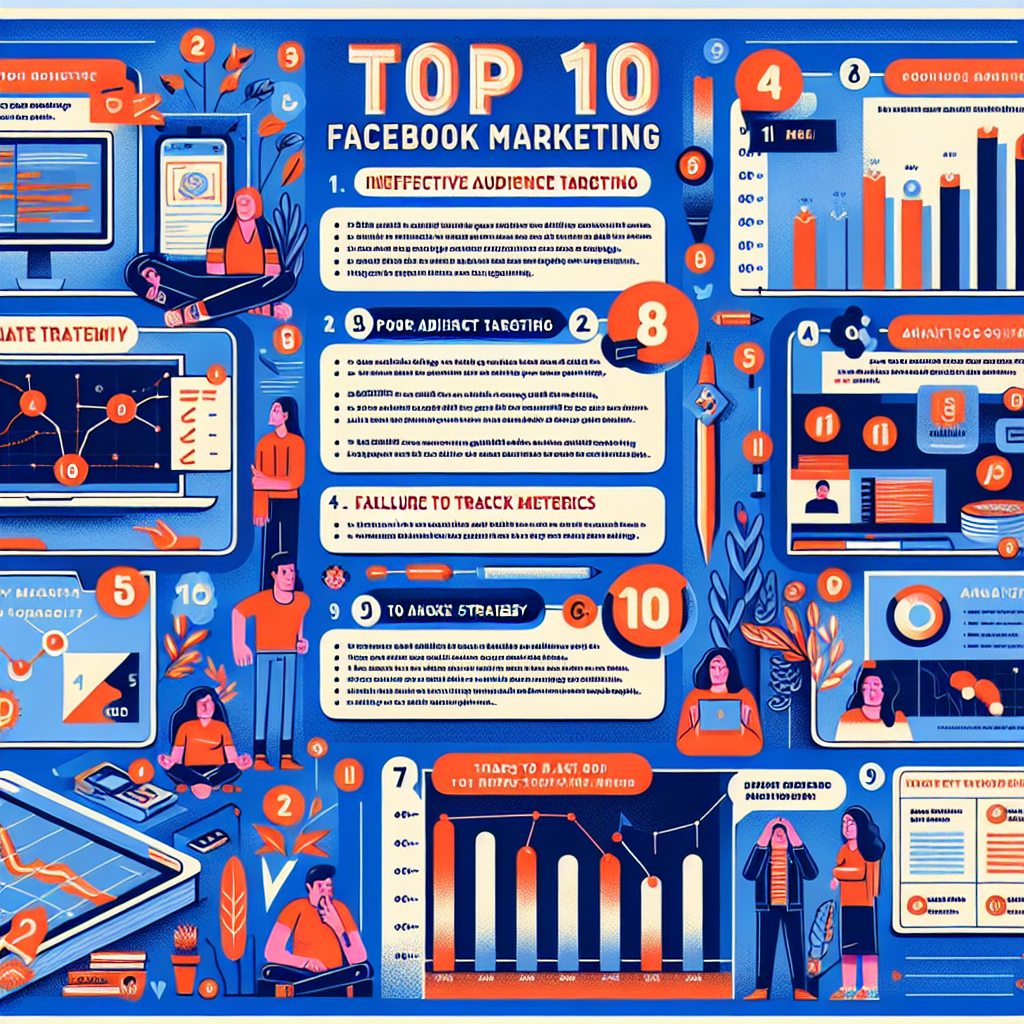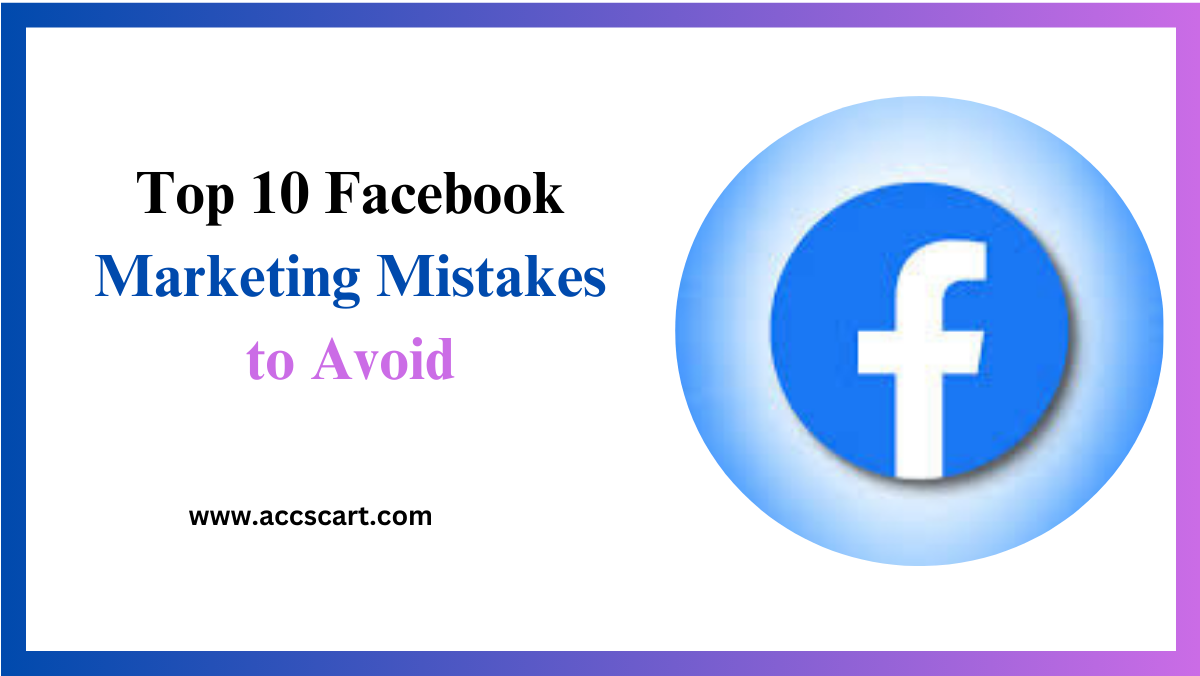In today’s digital age, Facebook remains a powerful tool for businesses aiming to reach a broader audience. However, many brands still falter in their Facebook marketing strategies, often due to common pitfalls that can easily be avoided. In this post, we’ll explore the top 10 Facebook marketing mistakes and provide actionable insights to help you steer clear of them.
1. Common Mistakes in Facebook Marketing
- Overlooking the Importance of a Clear Strategy
One of the most common mistakes is jumping into Facebook marketing without a well-defined strategy. A clear marketing strategy should outline your goals, target audience, content plan, and key performance indicators (KPIs). Without a concrete plan, your efforts may be scattered, making it difficult to measure success or make improvements.
- Misunderstanding Audience Targeting
Your content can be top-notch, but if it’s not reaching the right people, it won’t yield results. Misunderstanding or neglecting audience targeting can severely undermine your marketing efforts.
- Case Study:
A small apparel brand invested heavily in Facebook ads without properly targeting their audience. They initially saw a high volume of traffic but noticed that conversions were low. By refining their audience targeting to focus on individuals interested in sustainable fashion, they saw a significant increase in engagement and sales.
- Ignoring Analytics and Insights
Facebook’s Insights function offers an abundance of data. Ignoring this data means missing out on valuable information about your audience’s behavior, the performance of your posts, and overall page metrics.
Failing to Engage with Followers
Facebook is a social platform; the key word here is “social.” Brands that fail to engage with their followers miss out on building relationships and fostering loyalty. Responding to comments, participating in discussions, and addressing customer service inquiries are crucial for maintaining an active and engaged community.
2. Misunderstanding Audience Targeting
- Not Defining Buyer Personas
Buyer personas are fictionalized depictions of your ideal clients that are derived on actual data and market analysis. Without them, you may end up targeting too broad an audience, which can dilute your marketing efforts.
- Ignoring Demographic Insights
Facebook allows you to target users based on location, age, gender, interests, and behaviors. Ignoring these demographic insights can result in wasted ad spend and ineffective campaigns.
- Using the Same Content for All Audiences
varied kinds of content may elicit varied responses from different audience segments. Tailor your messaging to cater to the specific needs and preferences of each segment.
- Best Practice:
Conduct A/B tests with different audience segments to determine which content resonates best with each group. Use Facebook’s Custom Audiences feature to create highly targeted campaigns.

3. Ignoring Analytics and Insights
- Not Setting Up Facebook Pixel
The Facebook Pixel is an analytics tool that helps you measure the effectiveness of your advertising by understanding the actions people take on your website. If you’re not using Facebook Pixel, you’re missing out on valuable data that can help optimize your ads.
- Overlooking Post Performance Metrics
Metrics such as reach, engagement, and click-through rates provide insights into what content is working and what isn’t. To help guide your content strategy, evaluate these indicators on a regular basis.
- Failing to Monitor Ad Performance
Facebook Ads Manager offers detailed analytics on ad performance. Regular monitoring allows you to make data-driven decisions and adjustments in real-time.
- Case Study:
A tech startup launched a series of Facebook ads but noticed that one ad was underperforming. By analyzing the ad’s metrics, they identified that the image used wasn’t resonating with their audience. After switching to a more engaging visual, they saw a 35% increase in click-through rates.
4. Failing to Engage with Followers
- Not Responding to Comments and Messages
Engaging with followers in the comments section or through direct messages shows that your brand values customer feedback and is willing to engage in meaningful conversations.
- Posting Infrequently
Inconsistent posting can result in decreased engagement and reach. Develop a content calendar to ensure regular posting and maintain a steady presence on the platform.
- Ignoring User-Generated Content
Encouraging followers to share their own content related to your brand can boost engagement and foster a sense of community. Ignoring user-generated content is a missed opportunity to leverage authentic brand advocacy.
- Best Practice:
Create a branded hashtag and encourage followers to use it when posting about your products or services. Put user-generated material front and center on your page to foster community and express gratitude.
6. Ignoring the Power of Visual Content
- Overlooking Video as a Format
Video content is one of the most engaging formats on Facebook, with users often retaining more information when it’s conveyed visually. Brands that solely post static images or text updates may miss opportunities to capture audience attention.
- Inconsistent Branding
Retaining a unified visual aesthetic is essential to brand identification. Inconsistent imagery or branding across posts can confuse audiences and dilute your message.
- Best Practice:
Incorporate a mix of visual content, including videos, infographics, and branded images, to enhance engagement. Ensure that all visuals align with your brand identity for coherence.
7. Neglecting Paid Advertising Opportunities
- Relying Solely on Organic Reach
While organic reach is valuable, it can be limited on Facebook due to the platform’s algorithm changes. Relying solely on organic content may result in missed opportunities for reaching a larger audience.
- Not Experimenting with Ad Formats
Facebook offers various ad formats, including carousel, slideshow, and lead ads. Sticking to just one format can limit your campaign’s effectiveness and creativity.
- Best Practice:
Allocate a budget for paid advertising to boost visibility and reach. Experiment with different ad formats and placements to determine which works best for your audience and objectives.
8. Lack of Consistency in Posting
- Irregular Posting Schedule
An irregular posting schedule can lead to decreased audience engagement and a decline in brand visibility. Maintaining your audience’s interest and educating them requires consistency.
- Understanding Optimal Posting Times
Failing to analyze when your audience is most active can result in posts being missed. Proper timing can significantly impact engagement rates.
- Best Practice:
Utilize Facebook Insights to determine the best times to post based on when your audience is online. Develop a content calendar to schedule posts consistently, ensuring you remain active and relevant to your followers.
9. Failing to Adapt to Trends
- Ignoring Emerging Features
Facebook continuously evolves, introducing new features and tools that can enhance marketing strategies. Failing to leverage these updates can leave your brand behind competitors who are capitalising on the latest trends.
- Sticking to the Same Content Strategy
As trends in social media evolve, so too should your content strategy. Sticking to outdated methods may render your marketing less effective over time.
- Best Practice:
Stay informed about industry trends and Facebook updates. Regularly review and revise your content strategy to incorporate new features and formats that may benefit your approach.
10. Not Investing in Community Building
- Overlooking the Importance of Brand Community
Building a community around your brand can lead to greater loyalty and advocacy. Brands that treat followers as part of a community often enjoy higher engagement rates and customer retention.
- Disregarding Feedback and Criticism
Listening to your audience—whether it’s positive feedback or constructive criticism—can provide invaluable insights into how to improve your products and marketing efforts.
- Best Practice:
Create opportunities for community interaction, such as Facebook Groups or live Q&A sessions, where followers can engage with your brand directly. Encourage feedback and be responsive to your audience’s needs and desires, fostering a strong, supportive community around your brand.
Conclusion and Recommendations
Recap of Key Mistakes:
- Overlooking the Importance of a Clear Strategy
- Misunderstanding Audience Targeting
- Ignoring Analytics and Insights
- Failing to Engage with Followers
Actionable Takeaways:
- Develop a comprehensive marketing strategy with clear goals and KPIs.
- Define and understand your buyer personas to improve audience targeting.
- Utilize Facebook Insights and Analytics tools to monitor and optimize campaigns.
- Engage regularly with your followers to build relationships and foster loyalty.
Call to Action:
Are you prepared to advance your Facebook marketing efforts? Don’t make these typical errors to begin experiencing genuine outcomes. Sign up for our free webinar on advanced Facebook marketing strategies, and learn how to maximize your social media potential.
Learn More and Register Here
Avoiding these common Facebook marketing mistakes can significantly improve your brand’s online presence and engagement. By understanding audience targeting, leveraging analytics, and actively engaging with followers, your business can build a robust and effective Facebook marketing strategy.
Extra Tips:
- Always keep learning and stay updated with the latest Facebook algorithm changes and best practices.
- Consider investing in Facebook Blueprint courses to deepen your understanding of the platform’s advertising capabilities.
- Network with other marketers and join Facebook groups dedicated to social media marketing to exchange insights and strategies.
By incorporating these practices, you’ll be well on your way to mastering Facebook marketing and driving meaningful results for your business.









